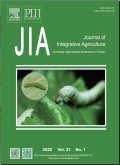首页|期刊导航|农业科学学报(英文)|Nitrogen rhizodeposition from corn and soybean,and its contribution to the subsequent wheat crops
农业科学学报(英文)2024,Vol.23Issue(7):2446-2457,12.DOI:10.1016/j.jia.2023.11.018
Nitrogen rhizodeposition from corn and soybean,and its contribution to the subsequent wheat crops
Nitrogen rhizodeposition from corn and soybean,and its contribution to the subsequent wheat crops
摘要
关键词
crop rotation/nitrogen rhizodeposition/meta-analysis/soil aggregates/nitrogen transferKey words
crop rotation/nitrogen rhizodeposition/meta-analysis/soil aggregates/nitrogen transfer引用本文复制引用
Sainan Geng,Lantao Li,Yuhong Miao,Yinjie Zhang,Xiaona Yu,Duo Zhang,Qirui Yang,Xiao Zhang,Yilun Wang..Nitrogen rhizodeposition from corn and soybean,and its contribution to the subsequent wheat crops[J].农业科学学报(英文),2024,23(7):2446-2457,12.基金项目
This work was financially supported by the National Key Technology Research and Development Program of China(2021YFD1901001-08),and the Key Scientific and Technological Project of Henan Provincial Education Department,China(232102111119). (2021YFD1901001-08)

